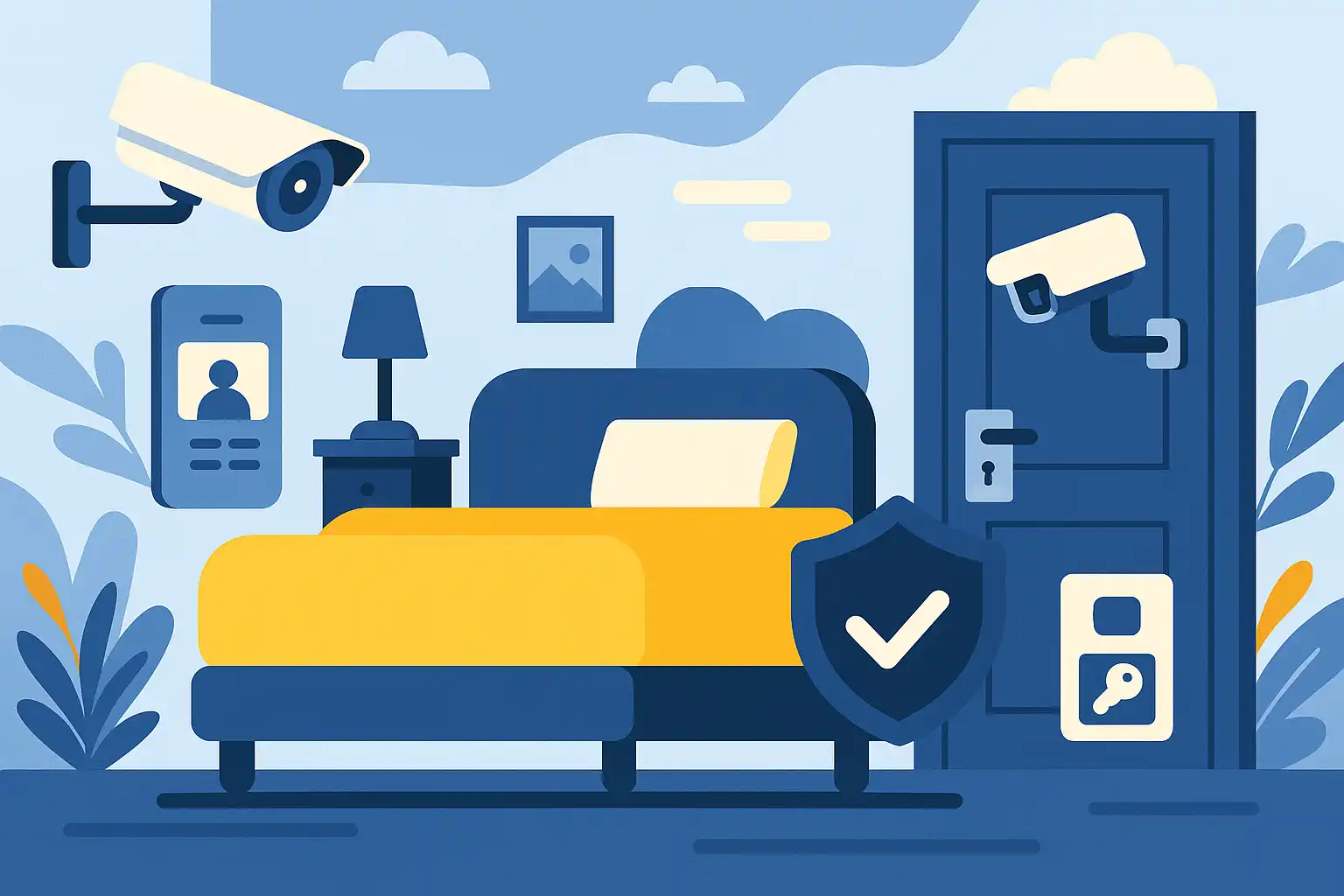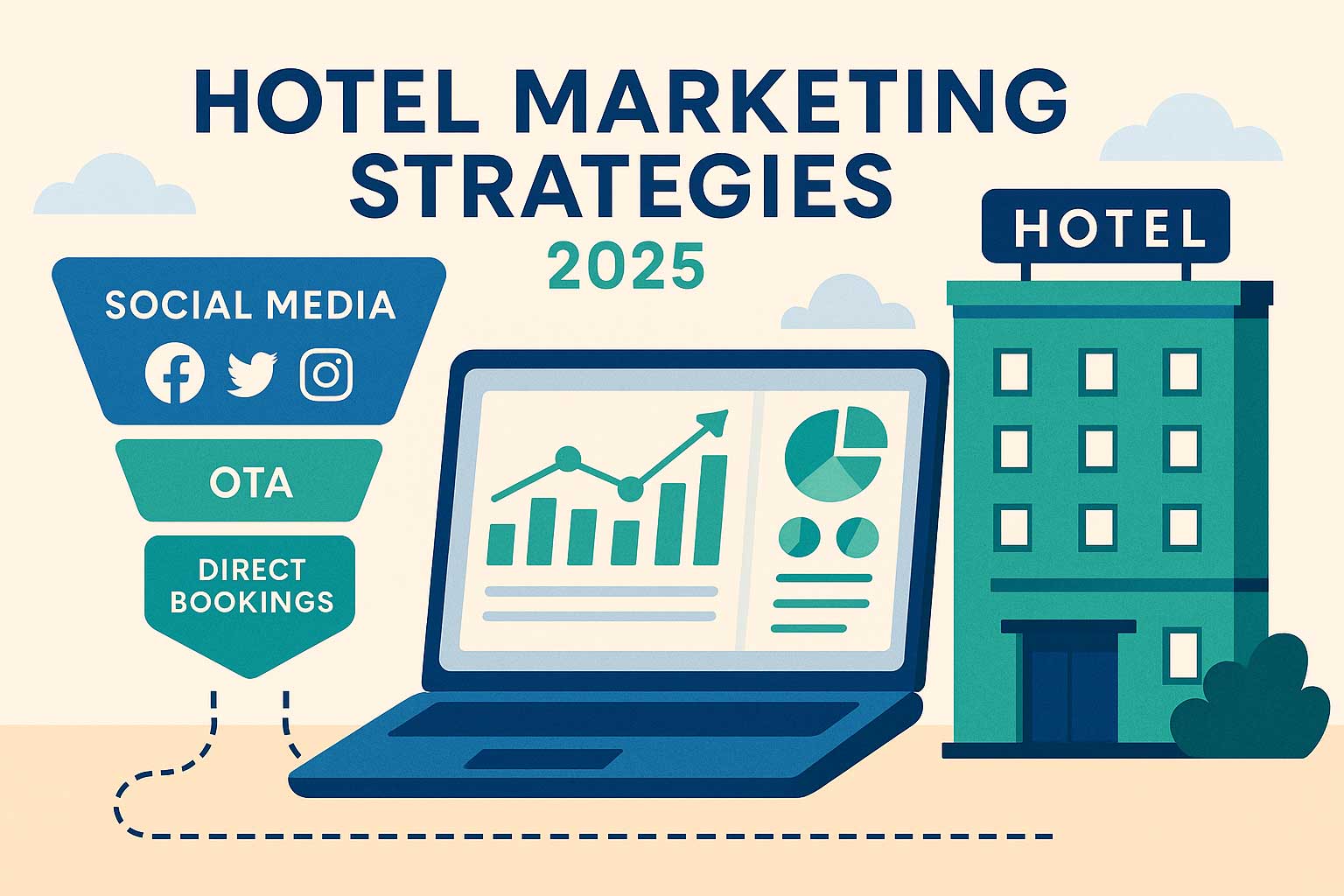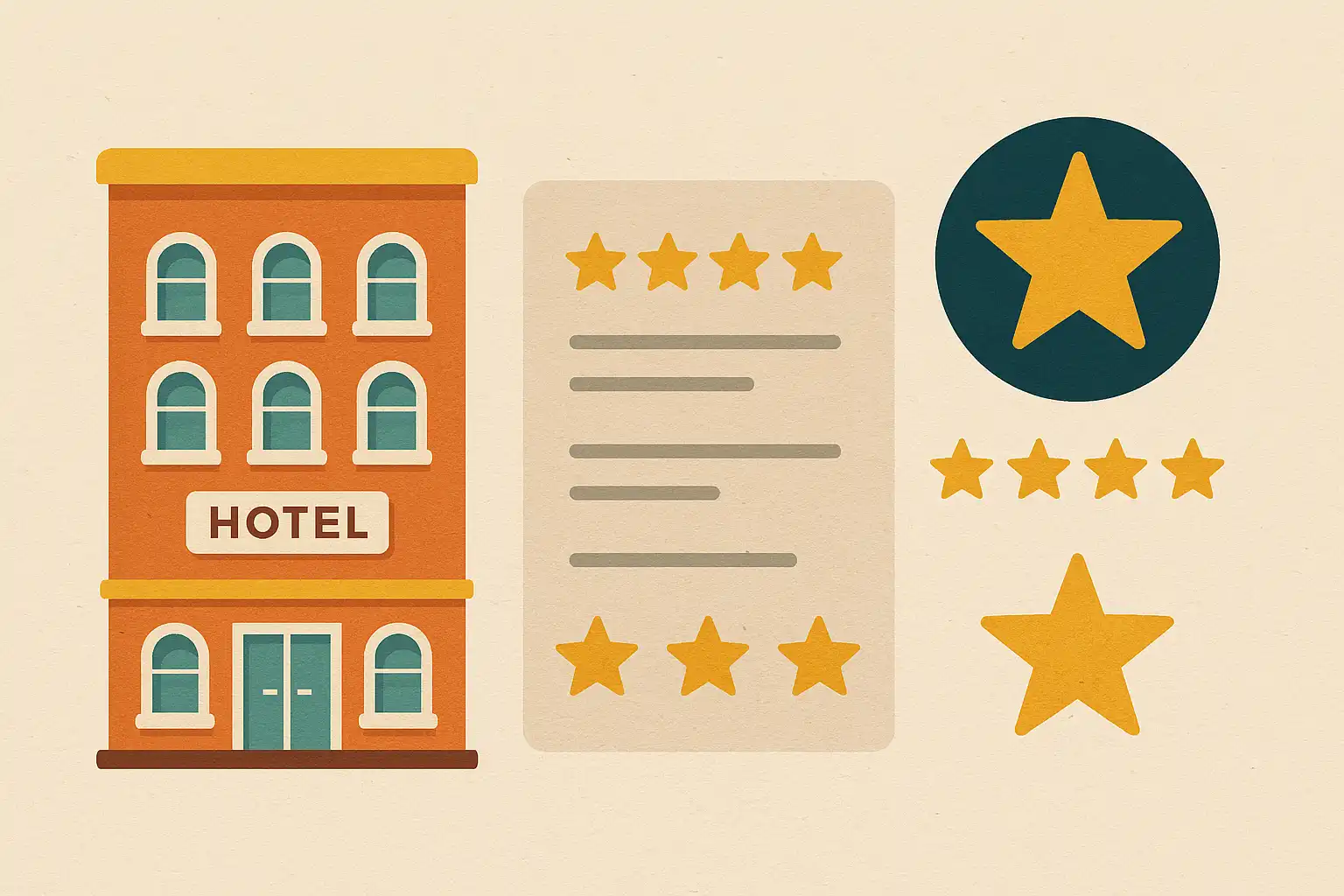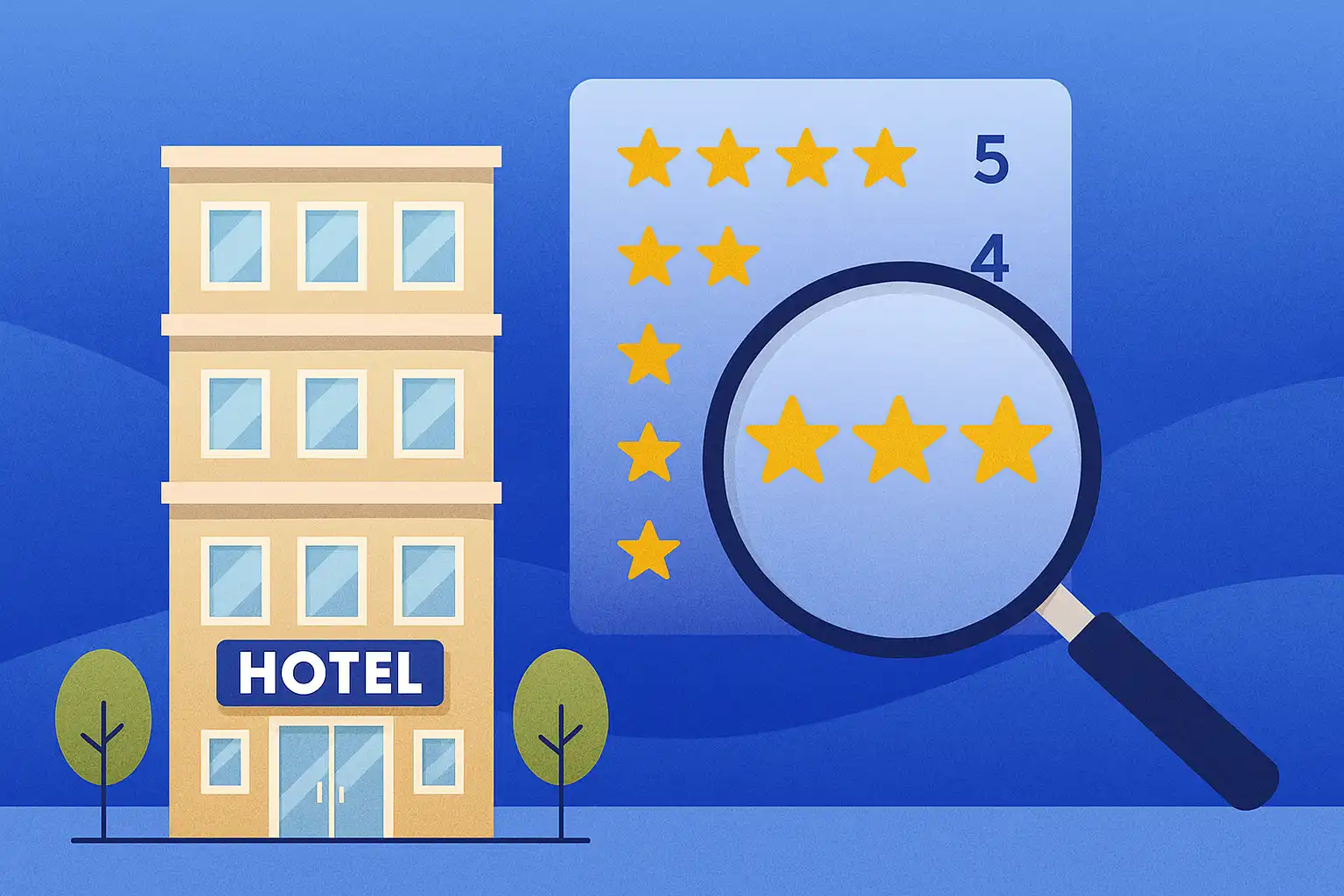Hotel Rating: Understanding Hotel Star Systems and Classifications
Oct 1, 2025
 Mika Takahashi
Mika TakahashiPopular Categories
Hotel Technology & InnovationHotel Operations OptimizationDigital MarketingIndustry TrendsRevenue ManagementHospitality Industry
Popular Categories
Trending Post

Hotel Walk Letter Template: Professional Guest Communication

Online Travel Agents: What They Are and How They Work

Hotel Security Systems: Modern Protection Solutions

Hotel Advertising: Complete Guide to Boost Bookings and Revenue

25 Hotel Marketing Strategy Ideas for 2025: Complete Guide

AI Reservation Agent: Revolutionizing Hotel Booking and Guest Experience

PMS Communication: Streamlining Property Management Through Effective Guest Messaging
Table of contents
If you’re a hotelier, understanding hotel rating systems is key to positioning your property in today’s competitive market. Whether you run a cozy boutique inn or a sprawling luxury resort, knowing how star ratings and classifications work can directly impact your hotel’s reputation, pricing, and ability to attract guests.
Hotel rating systems act as a universal language in hospitality, helping travelers quickly get a sense of your hotel’s quality, amenities, and service. But let’s be honest—these systems can feel confusing, especially when ratings vary across platforms or regions. This guide aims to clear up the mystery by breaking down the major global rating systems, explaining the criteria behind them, and sharing practical tips to boost your hotel’s classification and appeal.
The Role of Hotel Ratings in Hospitality Management
Hotel ratings are standardized frameworks that evaluate hotels based on factors like room quality, service excellence, amenities, and overall guest experience. They set clear expectations for guests and serve as a powerful marketing tool to elevate your hotel’s profile among discerning travelers.
A strong hotel star rating can make your property stand out in a crowded market, signaling consistent quality and exceptional service. For hoteliers, the trick is to align your operations with what rating bodies and guests value most.
Beyond traditional hotel star ratings, there are alternative systems like the American Automobile Association’s diamond rating and eco-certifications such as Green Key International. These newer classifications reflect changing guest preferences and offer hoteliers fresh ways to showcase what makes their properties unique.

Overview of Major Hotel Rating Systems Worldwide
Knowing the different hotel rating systems and how they work is essential if you want to optimize your hotel’s classification and market position.
Star Rating System
The hotel star rating system is the most widely recognized worldwide, ranging from one to five stars. It started with the Mobil Travel Guide in 1958 and evolved into what’s now the Forbes Travel Guide, known for its rigorous inspections that focus heavily on service quality and guest experience.
Forbes inspectors evaluate hotels against over 900 criteria, often visiting anonymously to ensure fairness. Earning a five star hotel rating here is a big deal—less than half a percent of hotels worldwide achieve it.
AAA Diamond System
Used exclusively in North America, the American Automobile Association (AAA) runs the diamond rating system. They assess hotels from one to five diamonds based on 27 detailed criteria covering hospitality, service quality, and facilities.
AAA’s diamond ratings put a spotlight on guest satisfaction, room comfort, and public area décor. Like Forbes, their coveted Five Diamond rating is reserved for hotels that deliver truly exceptional quality and service—only about 0.4% of hotels earn this honor.
European Hotelstars Union
Formed in 2010, the European Hotelstars Union brings together 24 European countries under a harmonized classification system. It uses a points-based approach with 247 criteria focusing on quality management, facilities, and service.
For example, a german hotel aiming for four stars must meet around 270 standards, including staff training and tech amenities. This system helps ensure consistent expectations across member countries, making it easier for hoteliers to meet a unified benchmark.
Regional Rating Organizations
- DEHOGA (German Hotel and Restaurant Association): Since 1996, DEHOGA has set formal hotel classifications in Germany, emphasizing technical standards, safety, and consistent service.
- Star Ratings Australia: Managed by the australian tourism industry council, this system evaluates hotels based on over 200 criteria, with a strong focus on guest satisfaction and facility quality.
- Tourism Grading Council of South Africa (TGCSA): This council grades South African hotels, incorporating cultural and service elements unique to the region.
| Rating System | Geographic Coverage | Key Focus | Scale |
|---|---|---|---|
| Forbes Travel Guide | Global | Service Excellence | 1-5 Stars |
| AAA Diamond | North America | Hospitality & Comfort | 1-5 Diamonds |
| Hotelstars Union | 24 European Countries | Standardized Amenities | 1-5 Stars |
| Star Ratings Australia | Australia/New Zealand | Guest Satisfaction | 1-5 Stars |
Decoding Star Levels: What Each Rating Implies for Your Hotel
Each star level in the hotel star rating system corresponds to specific benchmarks for accommodations, amenities, and service quality. Knowing these helps you tailor your hotel’s offerings to meet the expectations tied to your target classification.
One Star Hotels
One star hotels provide basic accommodations with essential amenities, serving primarily budget conscious travellers. Cleanliness, security, and fundamental services are must-haves, but extras like room service, fitness centers, or on-site restaurants are usually absent.
For hoteliers, focusing on these core standards is key to guest satisfaction and building a foundation for future upgrades.
Two Star Hotels
Two star hotels offer modest comfort with private bathrooms and basic amenities like TV and Wi-Fi. These mid range hotels provide better room quality than one star properties while keeping things affordable.
Typical features include daily housekeeping, simple room amenities, and limited food services. Delivering good quality service within these limits helps maintain positive guest reviews and steady bookings.
Three Star Hotels
Three star hotels strike a balance between comfort and value, offering amenities like fitness centers and on-site dining. They appeal to a wide range of travelers including business travelers and families.
You’ll find quality furnishings, improved room comfort, multiple dining venues, and concierge services here. Hoteliers should focus on consistent service quality and facility upkeep to meet these standards.
Four Star Hotels
Four star hotels deliver upscale accommodations with concierge services, multiple dining options, and luxury amenities. These hotels cater to travelers seeking premium experiences and personalized service.
Features often include spacious rooms with high-quality furnishings, gourmet dining at several restaurants, spa and fitness facilities, valet parking, and attentive guest care including turndown service. Anticipating guest needs is crucial at this level.
Five Star Hotels
At the top, five star hotels offer ultimate luxury with personalized service, Michelin-starred fine dining, and full-service spas. These leading hotels set the gold standard for exceptional service and comprehensive amenities.
Guests expect a wide range of premium offerings, including multiple world-class restaurants, bespoke guest experiences, and stunning architecture. For hoteliers, maintaining these standards means continuous investment in staff training, facility upgrades, and innovative guest engagement.

How Hotel Ratings Are Determined: Key Criteria and Evaluation Processes
Hotel star ratings come from thorough evaluations by independent organizations that assess hundreds of objective criteria. Understanding these processes lets you strategically improve your property to meet and exceed rating requirements.
These evaluations usually cover more than 200 criteria across categories like room quality, cleanliness, service standards, amenities, and facility condition.
Importantly, hotels don’t self-rate; they’re inspected by licensed agencies or tourism authorities. This impartial approach keeps hotel classification systems credible and trustworthy worldwide.
Forbes Travel Guide Methodology
Forbes inspectors visit anonymously, focusing about 70% of their assessment on the guest experience rather than just physical amenities. They stay as regular guests, evaluating service consistency, staff responsiveness, and how well the hotel anticipates guest needs.
They assess over 900 criteria, including room comfort, food quality, and staff training, giving a full picture of your hotel’s performance.
European Hotelstars Union Process
The European Hotelstars Union uses a points-based system with 247 criteria covering quality management, infrastructure, and service standards. Hotels must earn specific point totals to achieve hotel star ratings, ensuring consistent quality across member countries.
Key Evaluation Areas
- Room Quality: Inspectors look at bed comfort, furnishings, cleanliness, and in-room technology, including mattress quality and bathroom fixtures.
- Service Standards: Focus on staff training, professionalism, responsiveness, and problem-solving, including check-in/out and concierge services.
- Amenities: Evaluation covers restaurants, fitness centers, spas, business centers, and recreational facilities, considering both availability and quality.
Navigating International Variations and Specialized Classifications
Hotel rating systems differ around the world, shaped by local customs, regulations, and market needs. Knowing these differences helps you better position your hotel for international guests.
Asia-Pacific Variations
China’s system includes seven indicators emphasizing online service quality, data security, and tech integration, reflecting a digital-first hospitality approach.
Taiwan launched a new classification in 2024 focusing on sustainability and cultural authenticity alongside traditional quality metrics.
Regional Differences
In Mexico, star ratings aren’t standardized, with some hotels self-assigning ratings. This highlights the importance of managing your own ratings and online reputation proactively.
Specialized Classifications
The Salam Standard certifies over 55,000 Muslim-friendly hotels worldwide, evaluating criteria like halal food, prayer spaces, and culturally appropriate amenities.
Business travelers increasingly prioritize ratings that emphasize connectivity, meeting spaces, and location over traditional luxury features.
Alternative and Sustainable Rating Systems: Opportunities for Hoteliers
The traditional star rating system is evolving to include guest interests in sustainability and authentic experiences, opening new ways to stand out.
Environmental Certifications
- Green Key International: Certifies about 2,900 hotels in 57 countries for sustainable practices, assessing energy use, waste management, water conservation, and education.
- Green Globe: Audits companies on environmental, social, and economic sustainability.
Luxury Membership Organizations
Groups like Leading Hotels of the World focus on unique character and exceptional personalized service rather than star ratings, offering alternative prestige markers.
These alternatives recognize that boutique hotels can deliver unforgettable experiences without fitting traditional star rating molds.
Emerging Trends
Sustainability now includes renewable energy use, community engagement, and cultural preservation.
Cultural authenticity ratings assess how well hotels embrace local traditions and architecture, appealing to travelers seeking genuine experiences.
Strategies for Hoteliers to Improve Star Ratings and Guest Satisfaction
Raising your hotel’s star rating means improving physical standards, service quality, and operational efficiency.
Enhancing Physical Standards
Upgrade bedding, furnishings, and bathrooms to match your target star level. Quality furnishings and consistent upkeep are essential.
Add or improve amenities like fitness centers, modern lobbies, and tech features such as high-speed Wi-Fi, mobile check-in, and keyless entry. Pools, spas, and business centers are often crucial for higher star ratings.
Service Excellence Initiatives
Offer thorough staff training focused on guest interaction, problem-solving, and cultural sensitivity. Inspectors pay close attention to professionalism and how well staff anticipate guest needs.
Standardize operations and conduct regular quality audits.
Use guest feedback systems to spot areas for improvement and show responsiveness to concerns.
Operational Enhancements
Boost food and beverage offerings by diversifying menus, using local ingredients, and creating inviting dining environments. Four and five star hotels often require high standards in their restaurants.
Maintain strict housekeeping for cleanliness and room presentation.
Expand guest services like concierge, room service, and spa amenities to align with star level expectations.
Leveraging Online Reviews to Complement Official Ratings
Online reviews have transformed how guests assess hotels, often carrying as much weight as traditional star ratings.
Platform Influence
Sites like TripAdvisor, Google Maps, and Hotels.com aggregate guest-generated star ratings reflecting real experiences. Online travel agencies combine official ratings with guest reviews into scores that heavily influence bookings.
Balancing Traditional and Modern Ratings
Managing both official star ratings and guest review scores is vital. A hotel with a high star rating but poor online reviews may struggle to fill rooms.
Guest satisfaction scores affect search rankings on booking platforms, making reputation management crucial.
Strategic Review Management
Encourage guests to leave positive reviews through great service and timely follow-ups.
Respond professionally and promptly to all feedback, showing commitment to improvement.
Monitor review trends to address issues proactively and enhance guest satisfaction.
Blending traditional star ratings with strong online reputation management sets your hotel up for lasting success.
Conclusion: Harnessing Hotel Ratings to Drive Business Growth
For hoteliers, understanding and working with hotel rating systems is more than just branding—it’s a strategic necessity. These systems shape guest perceptions, pricing power, and competitive positioning.
By aligning your property with reputable rating criteria and actively managing guest experiences and reviews, you can elevate your hotel’s classification and attract loyal guests.
As hospitality evolves, expect rating systems to factor in sustainability, technology, and personalized service more deeply. Staying ahead means investing continuously and innovating—but the payoff is greater reputation, higher revenue, and long-term success in this dynamic industry.
